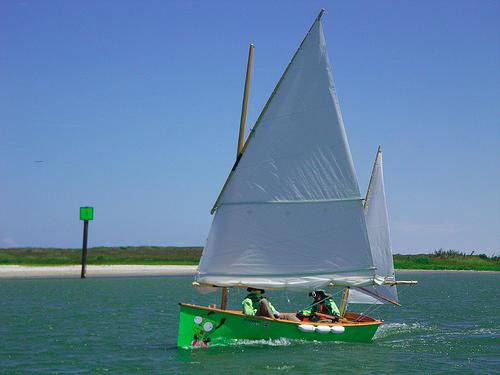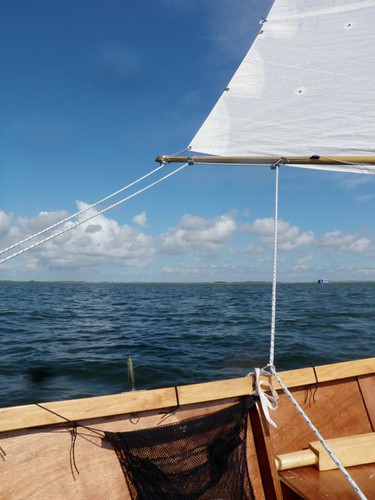John Goodman wrote me a letter post the Texas 200 giving a rundown on the performance of the Goat.

This was a predominantly light to medium wind event with wind from all points of the compass at some time or another.
John provided a nice summary of the event and included some sailshape pics.
________________________________________
Hi John, Thanks for the performance rundown!
I can hear how happy you are with the beast!.
Replies through your text.
On 29/06/2010 2:32 AM, John Goodman wrote:
Clint & Michael,
What a great Trip! The Texas 200 was a fantastic trip and the boat and rig performed very well. I think David and I were lucky this year because the previous years the wind was reported to be much higher.
Yes … it averaged about 20+ knots. One of the reasons I was motherhennish about you guys going in a Goat was because of the previous year and how my RAID41 design had a very hard time of it. It was rushed to launch and then joined on the third day for its maiden sail.
I did sail that boat later when I was in Texas … It is a lot of fun and quite sweet to handle, but really high sided making it hard to get aboard.
I received a few odd compliments from a few of the other sailors like; “This is the only Goat I have not seen the bottom of, most the time they are upside down.”, “You did not fall out of this one?” (RAID41 comment) and “You were all over the place the first few days, now you embarrass us all by passing us when there is no wind.”
A good sailor always has the advantage in light wind!
We traveled 197 miles per our GPS. That is 197 miles without a single boat related failure. That is a testament to a great boat design, great rig and good sails. The only problem was the traveler got in David’s way, since he liked to sit on the aft deck to steer.
I think you need to blame the building. The boat doesn’t fall apart because it has so few pieces and was put together very nicely. That’s the secret – choice of owners and epoxy deserves some credit too!
Here are a few pictures of the rig in action, but not with much wind. Maybe 10-12knots of breeze.
I am glad I read that this type of rig needs lots of down-haul tension.
On the gusty days we were able to depower the rig easily. We began to lower the rig instead of reefing. We would drop the halyard so the tip of the boom was an inch above the gunnels. This lowered the sails center of effort and made it much tamer during the big puffs.
That is interesting. A good solution for cruising when you don’t expect to tack or gybe much. Might be a bit dodgy if there is some uncertainty about needing to tack or gybe.
One thing I would consider doing is from this shot

I would suggest a loop through the clew eye and around the boom to prevent the clew moving away from the boom as the outhaul is eased. It will reduce the bending moment a little, but more importantly it will mean that the easing of the outhaul won’t mean the clew moves further away from the boom. This means that your easing will be translated more directly into more depth in the mainsail without increasing the sail twist.
The yard and boom are stiff and do not flex a lot. Compared to the other lug rigs, mine was very very stiff.
The mast was rock solid the whole trip. In the hard upwind, 12-15knot winds, sheeted very hard the tip of the mast would bend aft about eight inches. We very seldom used this amount of tension, but tried it for fun a few times.
Cool. Interested in feedback – Did you have some knots in the traveller to limit the boom to a 10 degree angle from the centreline?
I did that a few times and in moderate winds it gave a bit more pointing … particularly if the mainsheet was trimmed to get the leach ribbons flowing evenly.
I guess it would be possible to run a tighter traveller and add a control line from each side with a cleat each side to limit how far the traveller block can move to the side. We used to do that in the NS14 class. A wire (now it would be spectra) bridle that was quite tight and a separate rope each side to adjust the traveller.
Might be worth trying for those interested in tweaking performance.
You could centralise the traveller in light winds to minimise the sheet tension pulling the boom down. Then drop it to the 10 degree mark for average winds or let it that extra bit out to the gunwale for stronger winds, tight reaching or choppy water upwind.
The mizzen mast was flexible and during the big puffs the tip would flex a few to 6 inches. It did not ever vibrate during the higher winds. The mizzen sail would shake the mast if not trimmed tight enough. Only once during a series of tight tacks up a busy channel did we left the mizzen flog. I just could not concentrate on the mizzen with the wind gusts, barges, ferries and other large boats crossing back and forth.
Was the shaking of the mast from mast flexibility or from fit in the partner or both?
I see you have a halyard … I would sneak it around to the back face of the mast if I could. even if there is a hook on the back face it can be flicked under after hoisting. Gets rid of the drag of the halyard.
There is an alternative way of lacing the sail that may allow it to be hoisted and dropped but reduce the gap between it and the mast.
Start at one end like normal. then go around the mast to the first eyelet. Instead of continuing the spiral, come back the same way you came from (ie reverse direction to keep all the rope on the front of the mast). Then go to the next hole, put it through and reverse direction again. You might be able to get it a bit tighter to close the gap between the mast and sail.
On performance compared to the Sea Pearl 21 & Core Sound 17.
On the real tight upwind work in the channels the Sea Pearl had 2 tacks compared to our 6. Once off the breeze slightly we were faster in the mid range conditions. The day we slowly pulled away from both the Core Sound and the Sea Pearl it was a tight reach upwind in 10-15knots of breeze with some frustrating lulls down in the 5 knot range. One tack for 22 miles. We were full sail as they were. And yes, my competitive sailing skills were back and I was not about to let them pass me.
Haha … it comes out so easy doesn’t it!!!
Did you adjust the outhaul much …to get 10% camber in the bottom of the sail might help pointing in medium conditions and footing upwind in choppy and strong conditions. Flatten out when overpowered. For reaching with attached flow over the sail (tufts flying) you could adjust to a 1:7 camber for lots more power. And back to flat for running or broad reaching where the leach ribbons won’t fly.
The narrower boom angle might have reduced the number of tacks a bit. Also trim the mizzen for a little bit of weather helm. Tiller at about 3degrees to windward. Measure it so you know what it looks like.
That is all for now. It’s time to finalize the next 300 miles of my trip.
Heard about the hurricane. Glad it wasn’t last week!
Best wishes
Michael
<set_id=”72157624206188437″>
